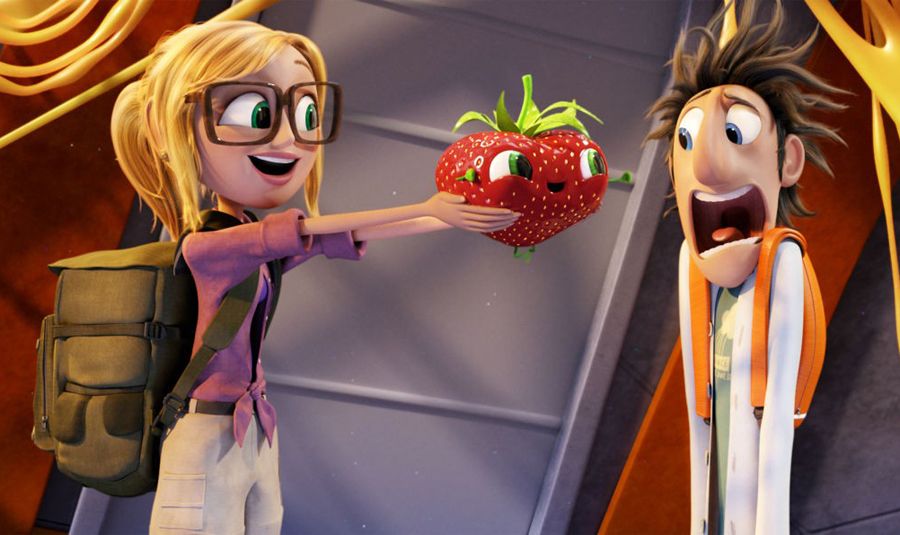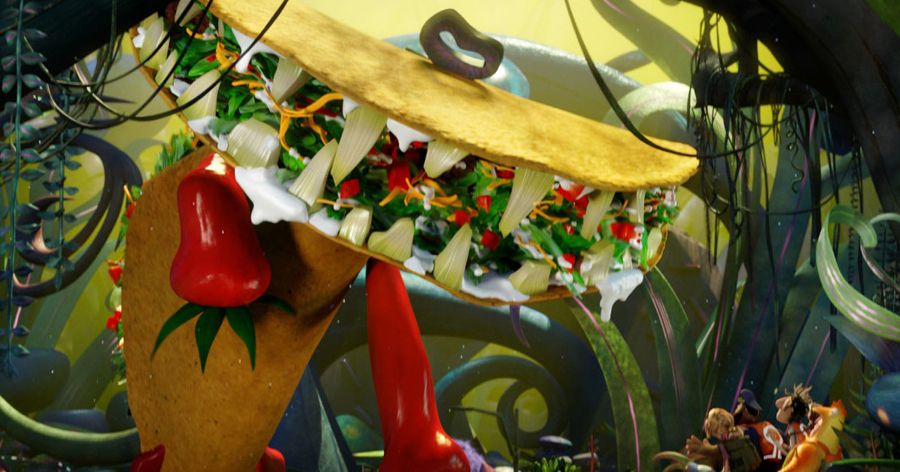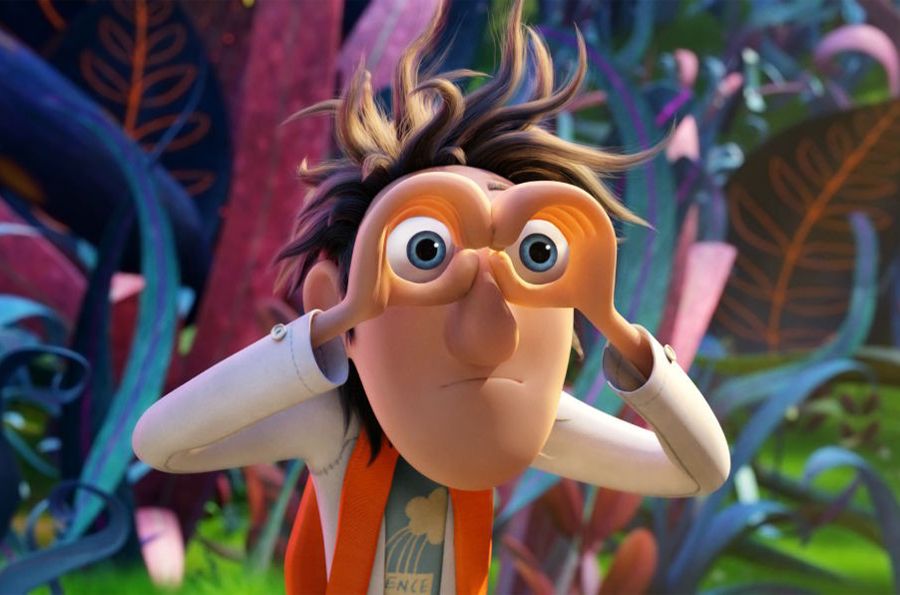Although it departed significantly from the book upon which it's based, Cloudy With a Chance of Meatballs was a surprise hit when it was released in 2009, and went on to become one of the most beloved animated movies of recent years, not to mention launch the careers of filmmakers Chris Miller and Phil Lord. Four years later, directors Kris Pearn and Cody Cameron are hoping that lighting will strike twice with the sequel, which opens Friday.
In the film, Swallow Falls becomes overrun with “foodimals” – creatures whose origins are pretty much what they sound like – and Flint and company find themselves dealing with a whole new buffet of problems. Switching from disaster epics to monster movies, Pearn and Cameron hope to rekindle the energy Lord and Miller created on the first feature while telling a different kind of story.
Pearn and Cameron sat down with Spinoff Online during Comic-Con International in San Diego to talk about the challenges of following up the first film’s success. In addition to discussing their inspirations, which included a variety of ‘80s movies, they offered details about the unique tone and storytelling conventions they utilized to make the sequel feel more like another single-serving meal rather than reheated leftovers.
Spinoff Online: The first movie had a great balance of sweetness and go-for-broke humor. When you took this on, how much were you planning to continue that and how much did you want to go in your own direction?
Kris Pearn: Definitely the tone from Cloudy 1 is something that we hoped to maintain going into this film.
Cody Cameron: We both storyboarded on the first one and we worked with Chris and Phil closely.
Pearn: And I think that the sweetness represents a big aspect of Flint’s personality, and that’s something that we wanted to challenge in this film – we wanted Flint to address it and kind of become aware of sort of his emotional center and who he loves. That was important to us because it was such a big story crack on the first one, trying to get that Tim-Flint story to earn [its payoff], so we didn’t want to abandon it. But I think our biggest itch in terms of what to evolve on this movie was on the story side for Flint was to take him to a new place, like imagine that he was the only guy in his town with a lab coat, so imagine he ends up in a place where everybody else has a lab coat. And we did explore that in the story process in the first film, so that was something we had chewed on before – so we wanted to give it its due, and sort of allow that to sort of be part of this story. We also wanted to change our angle in terms of what type of film it was; the first film was really a disaster movie, whereas this is more of a monster movie – what’s in the shadows, not what’s going to fall on your head, what’s hiding in the bush.
Cameron: And a little bit of that Alien-noble savage story.
Terry Crews Talks Mr. T, and What He Wont' Do For a Laugh
The first film is so iconoclastic in terms of its character types. What sorts of things are you doing in this movie that are doing the same thing?
Cameron: I don’t know if this is exactly answering your question, but in the first film Brent was a bully, and in this film he’s more of a lovable doof. In the first film he found a purpose being Chicken Brent, and so he really is a friend to the group now; he’s not so much that arrogant, grown-up child star any more – he’s got a little more heart.
Pearn: We definitely have our big archetypes – we have to be careful not to give way too much about the film, but within that noble savage story, we have the nods to the moment where characters begin to understand and empathize with each other. But I don’t know – we don’t want to give away sort of where the movie goes, but we definitely have moments like that. We mined those in the first film, trying to find those archetypes –
Cameron: Like not all of the food is necessarily bad.
Pearn: Yeah, so the food is people, too. Certainly the other aspect is we did a lot of observational stuff about what it’s like to go to high school for the first time, and we looked at a lot of those movies from the ‘80s like Real Genius and Teen Wolf —
Cameron: Can’t Buy Me Love.
Pearn: And then we inserted that kind of observational stuff into Flint’s story – like what’s it like to suddenly be popular and then how do not turn into a –
Cameron: How do you not lose your friends, and stay grounded?
How tough is it to move on from the growth that characters had in their relationships – to preserve those dynamics without repeating the dramatic stakes of the original film?
Cameron: You want to stay true to the characters and the world, which I think we’ve done, hopefully.
Pearn: I mean, definitely there was a bit of a gift in that the first film took so long for us to crack the story, so we definitely had a lot of these ideas that we played with, with Chris and Phil in the room, for many years. Like the idea of Flint going to his mentor’s – there was a whole scene in the first one with him going to Iceland that we cut.
Cameron: He visited a place called the Science League – I think for Phil and Chris, that might have been in their first draft or something.
Pearn: And then there was the whole idea of sentient food, which was still kind of in the first movie, but we didn’t really get a chance to scratch that itch. So when we started playing in this sandbox, it was like old days – it was Chris, Phil, Cody and myself sitting in a tiny room at Sony and the what-ifs. And I think that’s the only way you can tell a story like Cloudy – you can’t just assume it’s going to be brilliant out of the gate; you’ve got to throw a lot of spaghetti on the wall —
Literally.
Pearn: Literally!
Cameron: Are you tired of food puns yet? We’ve got more.
Pearn: (laughs) We were blessed with a great team, and a lot of them came back from the first film, from our story department all of the way down through animation team. And you ask 30 shut-ins to be funny and you get a lot of ideas coming at you.
This obviously lends itself to a lot of big sci-fi ideas. How tough was it to find the throughline that would be intriguing but in spite of ideas like “foodimals” it’s not overcomplicated?
Pearn: That’s always the dance, and that’s why at least in animated movies it takes years to make these things. We’ve been in the story room for two and a half years.
Cameron: From the very beginning Chris, Phil, Cody and myself, we knew there were things like we wanted to have an upside-down lab, or we wanted to have him go back to the island and have things overgrown. Or have this or that and then finding, what’s the story that uses a lot of those ideas and makes sure that we have something that’s emotional.
Pearn: And making sure that the meta isn't too meta. Like a big part of Cloudy 1 was Flint’s relationship with his own creativity, the machine being like his id – it was always a little bit ahead of him, so when he was heading into hubris, the machine was already there, and that was kind of the bigger isn’t always better motif. So we definitely have that at play in our film now, but we just want to make sure it’s simple, and the main assignment in story is to simplify, simplify, simplify, especially in a story that needs to play with the sound off – or to the widest possible audience. And I think the joy of Flint’s collision with his creativity being manifested by characters this time – these food creatures that have evolved from where they were in the last film – has given us so many creative opportunities. Like having James Caan to have a relationship with Flint’s kind of food children as a weird kind-of grandfather thing —
Cameron: He gets caught up with these pickles that he basically treats like grandchildren.
Pearn: And so that was something we didn’t expect when we first started the story process, but once we discovered it, it was like, wow that was delightful – and it become emotionally satisfying because it’s not just a gimmick. It starts to be more about Flint and Tim’s relationship. And you start to dig that out and find new things to say about it, as you hope you’ll end up finding as you go down that garden path.
How do you balance references to classic archetypes and movie characters with a sort of timelessness that doesn’t date the film?
Cameron: We definitely were inspired by the ‘80s films that we loved, not only the teen films but the Lucas and Spielberg and Richard Donner. Those types of films – really kind of crazy ‘80s films that we grew up on, Ghostbusters and things like. But I don’t think we ever tried to specifically parody anything —
Pearn: I think there might be one in this movie.
Cameron: There’s a few Jurassic Park jokes because, obviously, we have this big watering hole, and so we hit some of those moments.
Pearn: Some of them are so easy you just go, “OK.”
Cameron: Sam’s outfit for sure is based on Laura Dern’s, but hopefully we don’t do the types of lines that are just lifting it from another film and plugging it into our film.
Pearn: One of the things that Chris and Phil were really passionate about in the first film was that we would parody the idea of the genre, but not directly grab a reference from the film and shove it into the Cloudy world. But things felt like they were of that moment, you know what I mean? Flint is like Steve McQueen saying that will never happen again, you know; there are those kinds of references that, if you’re paying attention, you’ll catch them, and certainly with all of those movies from the ‘80s, as Cody said we had all of that rich stuff that we were poking at. And so there’s nods in there to a lot of different films, but more hopefully on the genre side, like that monster-movie world, and then the noble savage story. It’s like “food is people too.”




